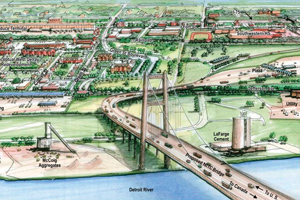Michigan, Canada Agree on Second Detroit Bridge After Governor Bypasses State Legislature

This story appears in the June 25 print edition of Transport Topics. Click here to subscribe today.
Michigan and Canada have signed an agreement to construct the long-awaited second bridge between Detroit and Windsor, Ontario, bypassing the Michigan Legislature, which has for years blocked the project.
Michigan Gov. Rick Snyder (R) and Canadian Prime Minister Stephen Harper signed a 54-page agreement on June 15, in a deal that includes $550 million in Canadian funds to cover Michigan’s share in the $950 million project. The funds will be repaid through tolls collected when vehicles have crossed the bridge into Canada, as part of a previously negotiated plan (5-10-10, p. 21).
The New International Trade Crossing will “help Michigan farmers, entrepreneurs and manufacturers get their goods to market faster, as well as develop new customer bases,” Snyder said.
The existing crossing between Detroit and Windsor — the Ambassador Bridge — is one of the busiest in the United States, supporting 1.3 million truck trips over the past year, according to a report from the Public Border Operators Association.
Active promoters of the NITC project include automakers on both sides of the border, as well as American Trucking Associations and the Canadian Trucking Alliance.
“ATA welcomes any and all new infrastructure across the U.S.-Canada border that improves and facilitates the transportation of freight for the largest bilateral trading relationship in the world,” said Sean McNally, vice president of communications at ATA.
“It’s been a long road to get to this day,” CTA President David Bradley said in a statement, “so we are thrilled the new crossing will become a reality.”
The second bridge will serve as an economic stimulus, providing jobs and state revenues, Kim Hill, director of sustainability and economic development strategies at the Center for Automotive Research in Ann Arbor, Mich., said in a statement.
“The region’s additional freight shipping capability could attract private-sector investment, augmenting the gross regional product and creating more employment opportunities,” Hill said.
The NITC will provide roughly 6,000 jobs each year during the projected four-year building project, said a study published June 14 from the CAR. A projected start date for construction is late next year.
The 83-year-old Ambassador Bridge is privately owned by Manuel “Matty” Moroun. He has carried
on a long battle to stop construction of a new bridge by influencing policymakers through campaign funding, said Tom Shields, spokesman for the coalition of business, labor and political leaders formed to support the new bridge proposal.
Snyder and former Gov. Jennifer Granholm, a Democrat, tried before, unsuccessfully, to persuade state legislators to approve a bridge plan. Snyder’s most recent attempt failed last year, leading him to push for this agreement directly with Canada.
“The governor has the legal ability to sign contracts with other states and countries,” Shields said. “Since there are no dollars coming from the state of Michigan for the bridge, this will be very beneficial to the public.”
Canadian and Michigan officials said they believe Moroun will try to stop the NITC, but they are confident their plan will stand.
“Whatever battles lie ahead, this bridge is going to get done,” Harper told the Detroit Free Press.
“We expect Moroun to throw everything . . . at this proposal, especially in the way of congressional acts,” Shields said. “I think the legal experts in the government’s office believe that this is Moroun-proof.”
Moroun has launched an effort to put a referendum on the November ballot, which would require voter approval for any international bridge, said Alan Upchurch, a spokesman for Moroun’s firm, Detroit International Bridge Co.
Mickey Blashfield, Moroun’s director of government relations, said the group already had collected more than 420,000 signatures, more than needed for the ballot plan.

